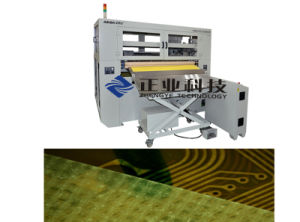Dust reduction system
When automatic sensor cleaning (also:. Anti- dust system, dust reduction system, English Dust Removal System, Dust Reduction System ) refers to technologies that are in digital SLRs ( SLRs ) to solve the problem of dust on the image sensor.
Dust deposition
For each objective change is the possibility that dust or other foreign particles from getting into the camera body and settle on the image sensor. However, even if the camera is not open, the smallest particles can be released inside the camera and sticking to the sensor. This can be caused by mechanical abrasion of moving parts ( for example, by closing or return mirror ). With zoom lenses, depending on the type wherein actuation of the zoom air and therefore dust are sucked into the interior of the camera.
For SLRs, working with film, this represents less of a problem because the contaminants are transported further with the film. Not so with digital SLRs: Keep it on the sensor from even microscopic particles of 0.1 mm in size on all the recorded images can then be displayed as gray spots. Cleaning tests with commercially available purification kit always run the risk of damaging the sensor. So there is often only - usually payable - Terms of Warranty Service for sensor cleaning.
Dust particles may adhere to the sensor for two reasons: due to electrostatic charge, and by intermolecular forces of attraction.
Dust particle deposition due to electrostatic charge
Dirt on the image sensor consist mainly of particles of about 1 micron (0.001 mm) size, which adhere by static electricity. The particles carry a positive electric charge, the sensor on the other hand is negatively charged, so both are attracted to each other. A similar phenomenon can be observed on the surface of CRT or LCD monitors.
Dust particle deposition by molecular attraction forces
Although the attractive forces between molecules are not as strong as the electrostatic. But they are sufficient to capture microscopic particles, such as droplets of moisture on the sensor surface. Unlike electrostatic charge here to help no grounding. Since the molecules adhere very closely to the adhesion surface, they are also harder to remove dust protection systems. However, this problem rarely occurs.
Manufacturer
The problem of dust settling on the image sensors of digital SLR cameras was first taken by Olympus in attack. Olympus paid in 2003 his first D- SLR, the E-1, with their Supersonic Wave Filter. Other manufacturers such as Canon, Pentax and Sony followed with their own developments. Panasonic and Leica, however, use the Olympus dust reduction system.










